In this post, I’ll show you how to master Human to Cat Translator apps in minutes, sharing tips that deepened my bond with my tabby, Luna. You’ll get my vetted app recommendations to avoid scams and connect with your cat.
Click on the above button to download Cat Translator App for iPhone.
Here’s what we’ll cover:
- What Are Human to Cat Translators?
- Human to Cat Translator apps: How they work, top 2025 picks and benefits.
- Get practical tips: Choose and use apps to strengthen your human-feline bond.
- Cat Communication and Bonding
- Learn cat communication: Decode meows, purrs, body language, and scent cues.
- Scientific skepticism and ethical concerns of feline language tools.
- Science, Limits, and Future Tech
Human to Cat Translator apps use AI and soundboards to mimic or decode cat sounds, boosting human-feline communication bridge.
I’ve guided cat owners to avoid fakes. A list of apps that you should never download from unverified sources!

Language of Cats: Beyond the Meow
Cats. They’re mysterious, independent, and let’s be honest, sometimes a little sassy.
But if you’ve ever locked eyes with a feline friend and wondered, What’s going on in that furry head?, you’re not alone.
I’ve spent years decoding my own cats’ quirks, from the demanding yowls at 3 a.m. to the slow blinks that make my heart melt.
Cats have a rich, complex language that goes way beyond the meow, and I’m here to walk you through it like a friend spilling the tea on their latest obsession.
I’ll explain: cats communicate through vocalizations, body language, scent marking, and tactile behaviors, each with its own nuances.
Understanding this language isn’t just cool, it’s a game-changer for your bond with your cat. Whether you’re a seasoned cat parent or a newbie, mastering their signals helps you respond to their needs, avoid misunderstandings, and, frankly, keep the peace in your home.
Let’s understand what this language is, why it matters, and how you can put it to work.
Vocal Communication
Cats are chatty in their own way, and their vocalizations are like a symphony of emotions, needs, and opinions. Back in the day, I thought a meow was just a meow. 1000% WRONG. Cats use a range of sounds—meows, purrs, hisses, chirps, and more—to express everything from “Feed me now” to “I’m not thrilled about this vet visit.” Each sound has a purpose, and decoding them is like learning a new dialect.
Meow
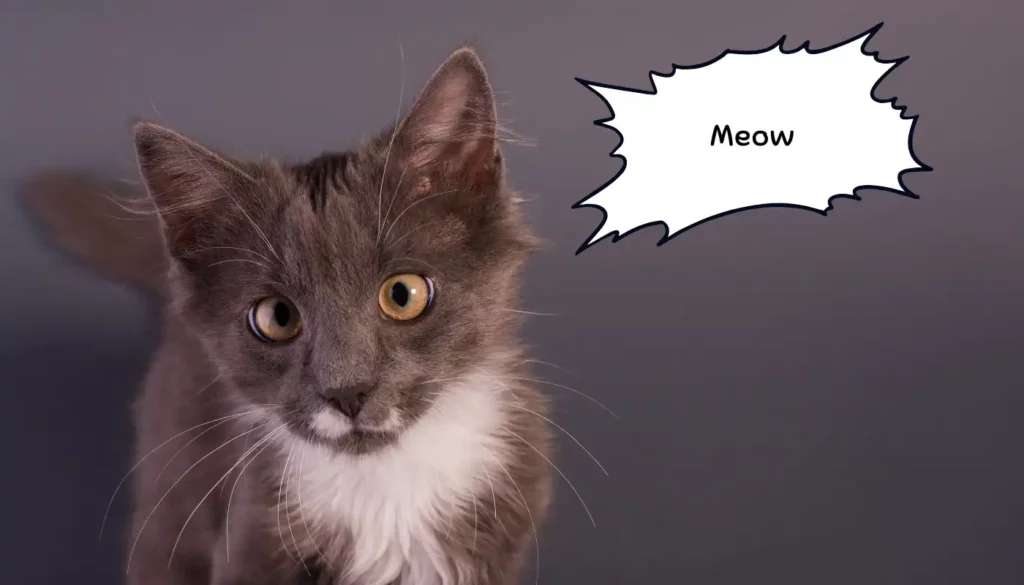
The cat meow meaning varies wildly. Meows are primarily for humans—wild cats rarely meow to each other. My tabby, Luna, has a whole meow vocabulary, and I’ve learned to pick up on her tones like a pro.
- Greetings: A short, soft meow when you walk in? That’s your cat saying, “Yo, good to see you!” Luna does this every morning, like she’s checking me in for the day.
- Demands (food, water, attention): A loud, insistent meow—think opera singer vibes—means your cat wants something. Food, a chin scratch, or maybe just your undivided attention. Simple.
- Pleading (going outside): A drawn-out, almost whiny meow is your cat begging for the great outdoors. My old cat, Max, would do this at the door, staring like I was denying him his destiny.
- Protest (displeasure): Sharp, grumpy meows signal annoyance. Step on a tail? Forget to clean the litter box? You’ll hear about it.
- Mimicking Human Words: Some cats get fancy and mimic our speech patterns. (According to a 2023 study on feline behavior) Siamese cats are notorious for this, turning meows into something eerily close to “hello.”
Cool Tip: Record your cat’s meows and note the context. Over time, you’ll spot patterns and know exactly what each one means. It’s like building a custom cat dictionary.
Bottom line? Meows are your cat’s way of talking directly to you. Pay attention to pitch and frequency to crack their code.
Purr
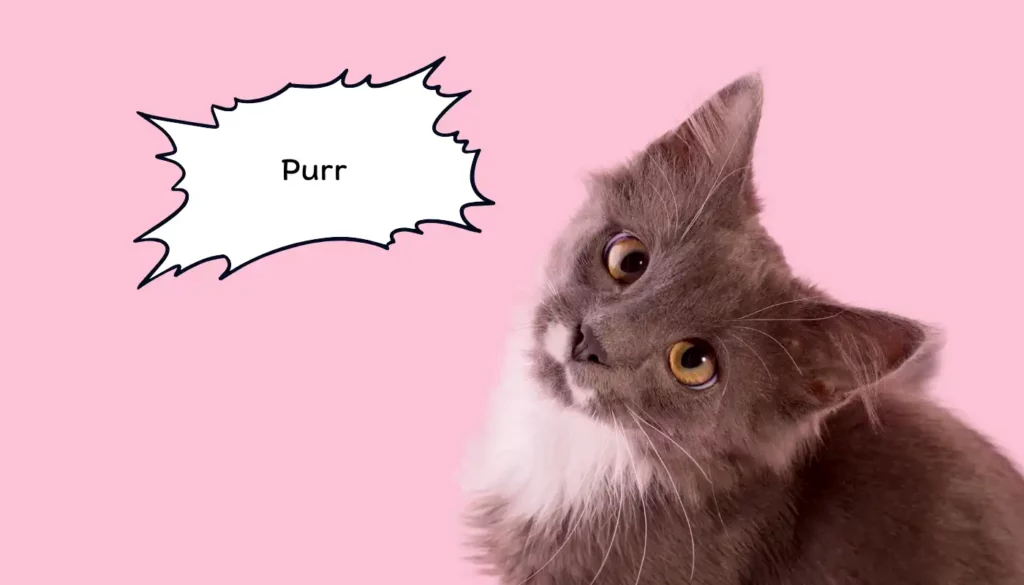
The cat purr meaning is pure magic, but it’s not just about contentment. I used to think purring meant Luna was in kitty nirvana. Here’s the catch: cats purr for a bunch of reasons, and not all are happy.
- Contentment: That soft, rhythmic purr when your cat’s curled up on your lap? Pure bliss.
- Hunger: A more urgent, high-pitched purr can mean “Where’s my dinner?” Luna pulls this when her bowl’s empty.
- Anxiety: Cats purr when stressed—like at the vet—to self-soothe. It’s their version of stress-eating.
- Seeking Attention: A purr paired with a nudge is your cat saying, “Pet me, human.”
- Soothing Mechanism: Purring releases endorphins, calming your cat in tense moments.
- Promoting Healing: Fun fact—purring vibrates at 20-140 Hz, a range linked to tissue regeneration. Cats literally purr to heal themselves.
Cool Tip: Next time your cat purrs, check their body language. Relaxed posture means they’re content; tense or wide-eyed could signal stress or hunger.
Purring is a Swiss Army knife of communication—comfort, need, or even self-care. Listen closely to tell the difference.
Growl, Spit, Hiss
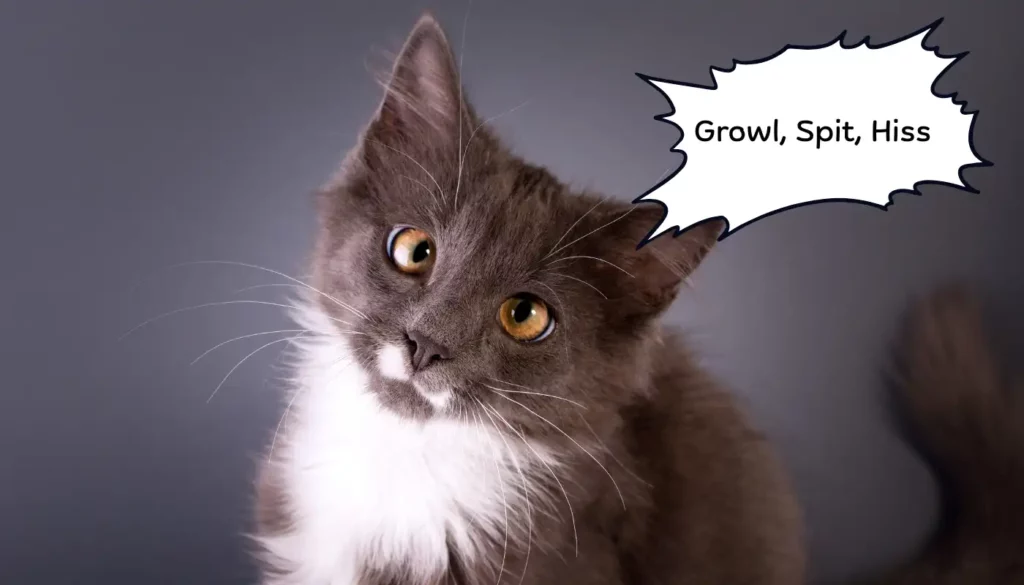
These are your cat’s “back off” signals. The cat hissing meaning is unmistakable—fear or aggression. When Luna first met my friend’s dog, she let out a hiss that could’ve stopped traffic.
- Aggression: Growls and spits mean your cat’s ready to throw paws. It’s a warning to rivals or threats.
- Fear: Hissing often comes from feeling cornered or scared. Luna hisses at the vacuum like it’s her mortal enemy.
Cool Tip: If your cat hisses, give them space. Forcing interaction can escalate things. Toss a toy to redirect their energy.
These sounds are your cat’s way of setting boundaries. Respect them, and you’ll avoid a scratch or two.
Chirrup
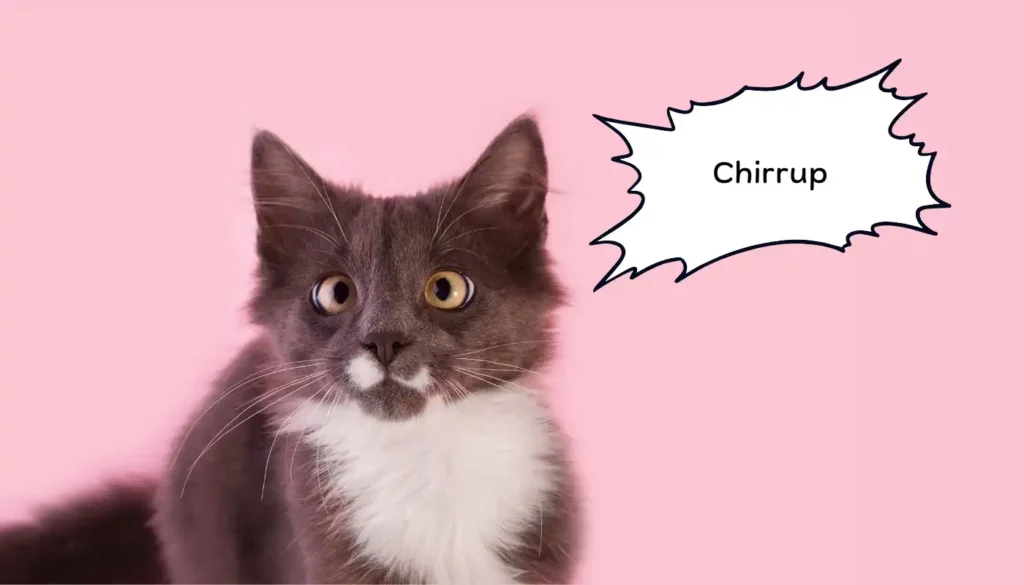
A chirrup is a friendly, musical sound, like a rolled “r.” It’s your cat’s version of a warm handshake.
- Friendly Greeting: My cat chirrups when I come home, like she’s saying, “Hey, buddy!”
- Mother to Kittens: Moms use chirrups to call their kittens. Domestic cats extend this to their humans.
Cool Tip: Mimic your cat’s chirrup to bond. It’s like speaking their language, and they’ll love the effort.
Chirrups are all about connection—your cat’s way of saying, “We’re cool.”
Chirp
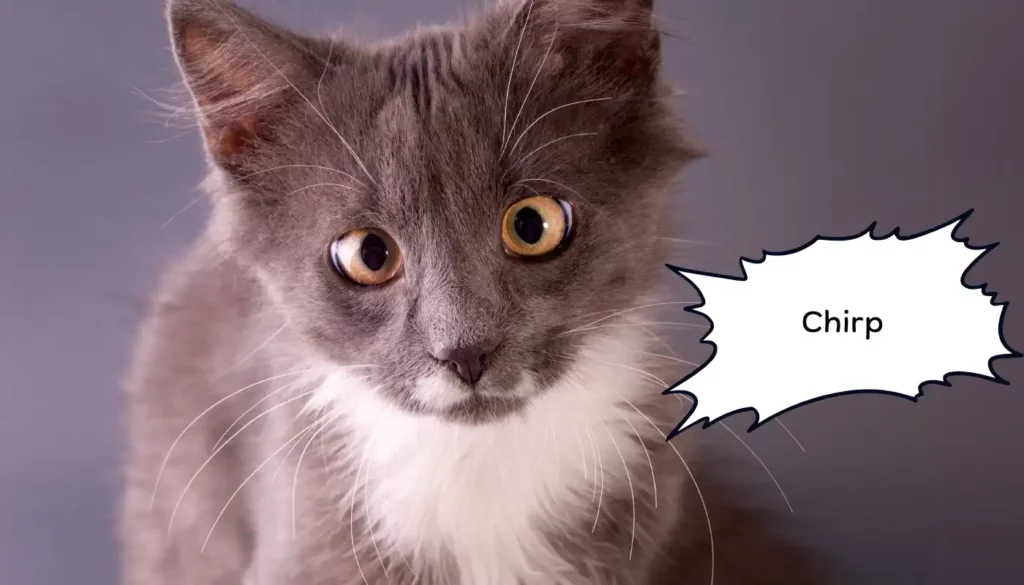
Chirps are short, high-pitched bursts of excitement, often tied to prey. Luna chirps at birds outside, her tail twitching like crazy.
- Excitement at Prey: That chatter when your cat spots a bug? It’s their hunting instinct kicking in.
Cool Tip: Engage your cat’s chirping with a laser pointer. It mimics prey and keeps them entertained.
Chirps are your cat’s inner hunter coming out to play.
Call, Howl, Moan, Wail
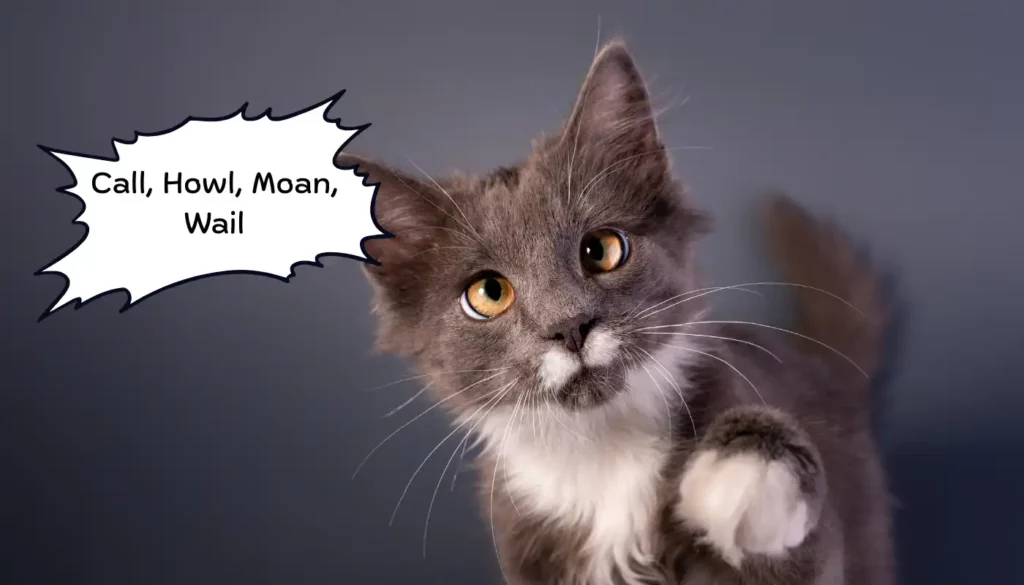
These are intense vocalizations, often tied to distress or anger. When Max got stuck in a closet, his wails were heart-wrenching.
- Distress: Howls and moans signal pain, fear, or being trapped.
- Anger: A low, guttural moan means your cat’s pissed. Step away.
Cool Tip: If your cat howls out of the blue, check for health issues or stressors. A vet visit might be in order.
These sounds are red flags—your cat’s crying for help or warning you to back off.
Caterwauling
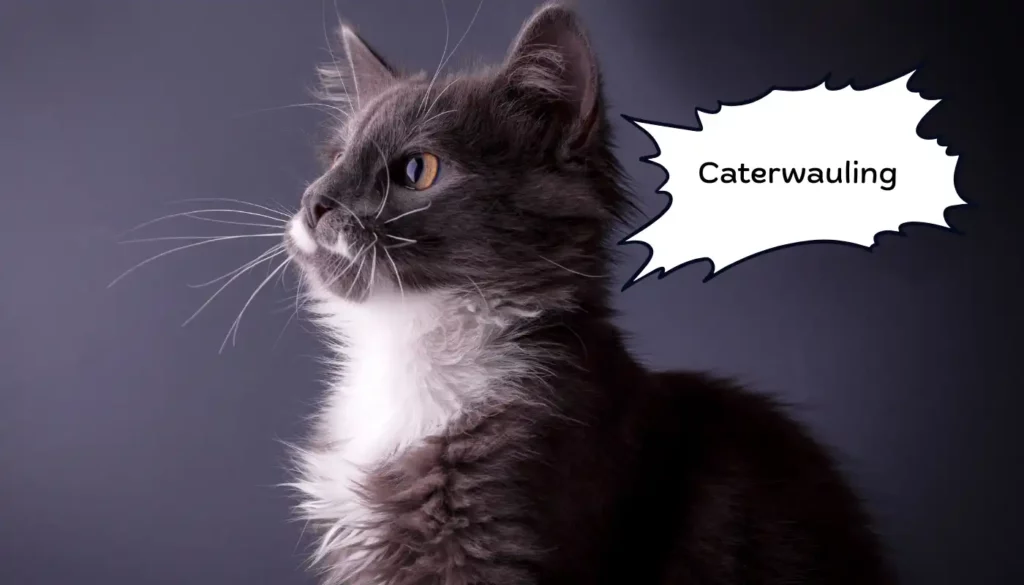
Linked to heat cycles, caterwauling is a loud, yowling sound unspayed females make to attract mates. It’s… intense.
Cool Tip: Spay your cat to avoid caterwauling. It’s kinder to them and your eardrums.
Caterwauling is a hormonal SOS—fix it with a vet visit.
Body Language
Cats are masters of non-verbal communication, and their cat body language speaks volumes. I learned this the hard way when Luna’s tail thrashed during a petting session—spoiler: she was not happy. From tails to ears to eyes, every move has meaning.
Tail
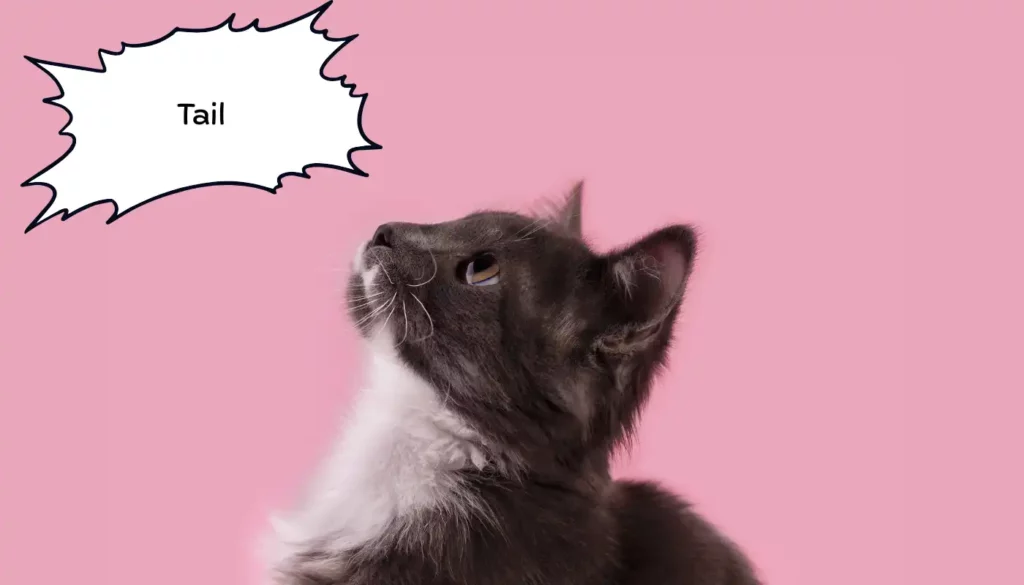
The cat tail language is like a mood ring. Luna’s tail is my go-to for gauging her vibe.
- Vertical (happy, confident, greeting): A straight-up tail means your cat’s feeling great. Luna does this when she greets me.
- Twitching (playing): A flicking tail signals playtime or hunting mode.
- Half-Raised (less pleasure): A droopy tail shows mild contentment but not full-on joy.
- Low (discontent): A tucked tail screams discomfort or fear.
- Swinging Slowly (relaxed): A lazy sway means your cat’s chilling.
- Twitching Tip (hunting, alert, playful): That little tip twitch? Your cat’s locked onto something.
- Low and Thrashing/Thumping (irritated, angry): Back off—this tail says trouble.
- Quivering (excited greeting, urine marking): A vibrating tail can mean joy or marking territory.
- Erect Hairs (scared, surprised, excited): Puffy tail? Your cat’s spooked or hyped.
Cool Tip: Watch your cat’s tail during play. A thrashing tail means they’re overstimulated—time to pause.
Tails are your cat’s emotional billboard. Learn their signals, and you’ll know their mood instantly.
Posture
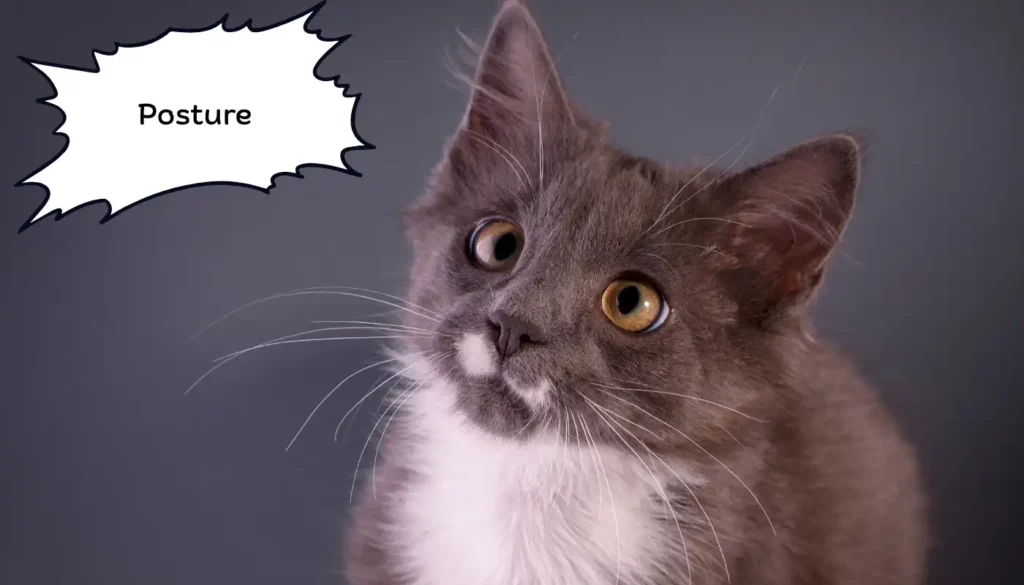
Your cat’s posture is a window into their headspace. Luna’s gone from crouched and fearful to strutting with confidence, and each stance tells a story.
- Relaxed (lying, sitting): Sprawled out or loafing? Your cat’s at ease.
- Fearful (crouching low): A low crouch means they’re scared or unsure.
- Terrified (shaking, stiff legs): Shaking or rigid? They’re freaking out.
- Aggressive (stiff legs, arched back): The classic Halloween cat pose screams “I’m ready to fight.”
- Confident (tail up): A high tail and steady walk mean your cat’s owning the room.
- Alert (lying or sitting, back horizontal): Perked up and focused? Something’s caught their eye.
- Tense (slinking): A sneaky slink means caution or hunting.
- Anxious/Ovulating (low body, tail movement): Low posture with tail flicks can signal stress or heat.
- Stretching (relaxed): A big stretch is your cat saying, “Life’s good.”
- Yawning (relaxed, playful): A yawn can mean calm or an invite to play.
Cool Tip: Mimic your cat’s relaxed posture during bonding time. Sit low and move slowly to make them feel safe.
Posture is your cat’s body telling you their emotional state. Notice the details, and you’ll get it.
Ears
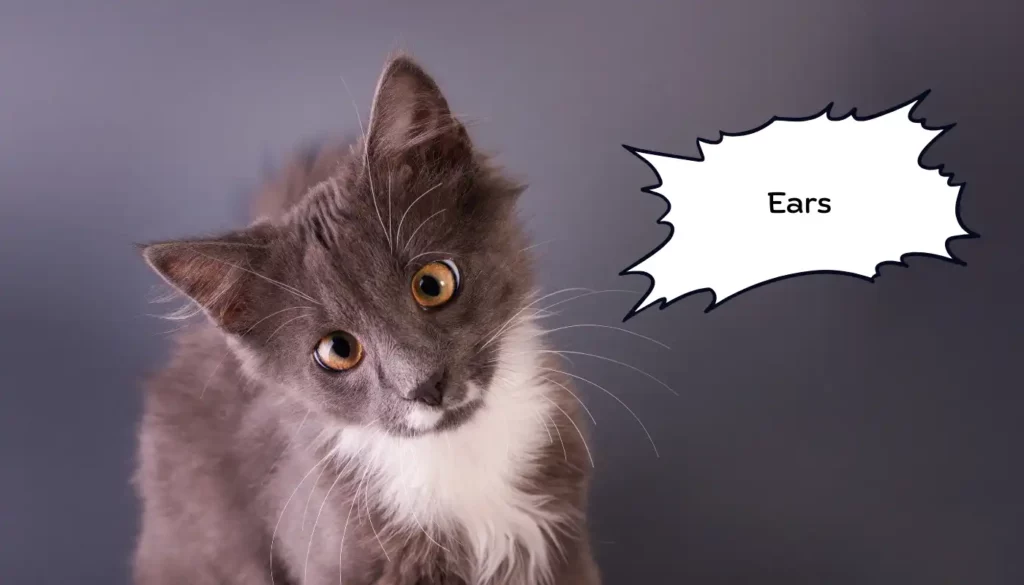
The cat ear position meaning is subtle but critical. Luna’s ears are like little radar dishes, always giving me clues.
- Erect (alert, focused): Upright ears mean your cat’s tuned in.
- Slightly Relaxed (calm): Slightly tilted ears show they’re chill.
- Flattened (defensive, aggressive): Flat ears? Your cat’s on edge or ready to rumble.
Cool Tip: If your cat’s ears flatten, stop what you’re doing. Give them space to calm down.
Ears are your cat’s mood antennas—watch them to stay in sync.
Eyes
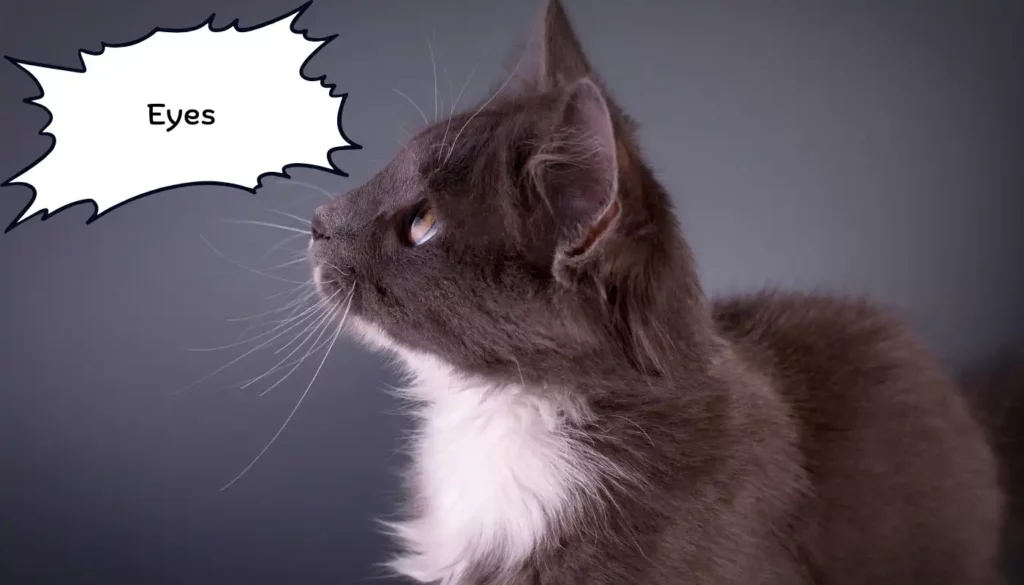
The cat eye language is intense. Luna’s slow blinks are my favorite, but her stare-downs? Yikes.
- Direct Stare (challenge, threat): A hard stare is a power move. Don’t stare back—it’s a challenge.
- Slow Blink (trust, affection): Slow blinks are kitty kisses. Try blinking back to bond.
- Wide Pupils (fear, stress, excitement): Big pupils mean high emotions—good or bad.
- Small Pupils (contentment, focus): Narrow pupils signal calm or laser focus.
Cool Tip: Practice slow blinking with your cat. It’s a trust-building superpower.
Eyes are your cat’s emotional windows. Learn their signals, and you’ll deepen your connection.
Whiskers
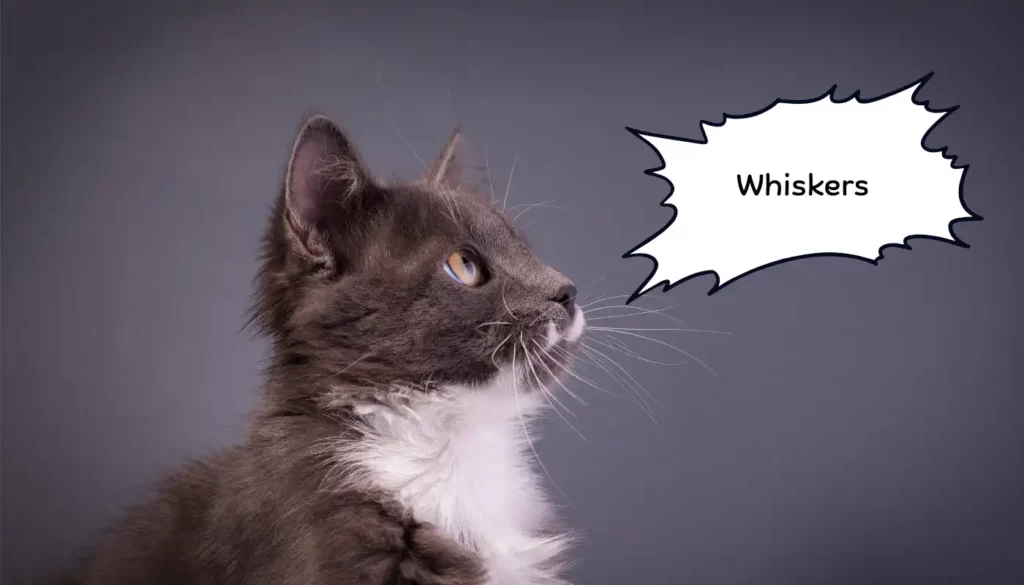
The cat whisker language is subtle but telling. Luna’s whiskers are like mood indicators.
- Relaxed (content): Spread-out whiskers mean your cat’s happy.
- Back (fear): Pulled-back whiskers signal stress or defensiveness.
Cool Tip: Check whiskers during petting. If they pull back, ease up—they’re not comfy.
Whiskers are small but mighty clues to your cat’s feelings.
Scent Marking (Olfactory Communication)
Cats are scent wizards, using pheromones and physical actions to claim their world. When Luna rubs her cheek on my leg, she’s not just being cute—she’s marking me as hers. Why do cats spray? It’s all about territory and communication.
Pheromones
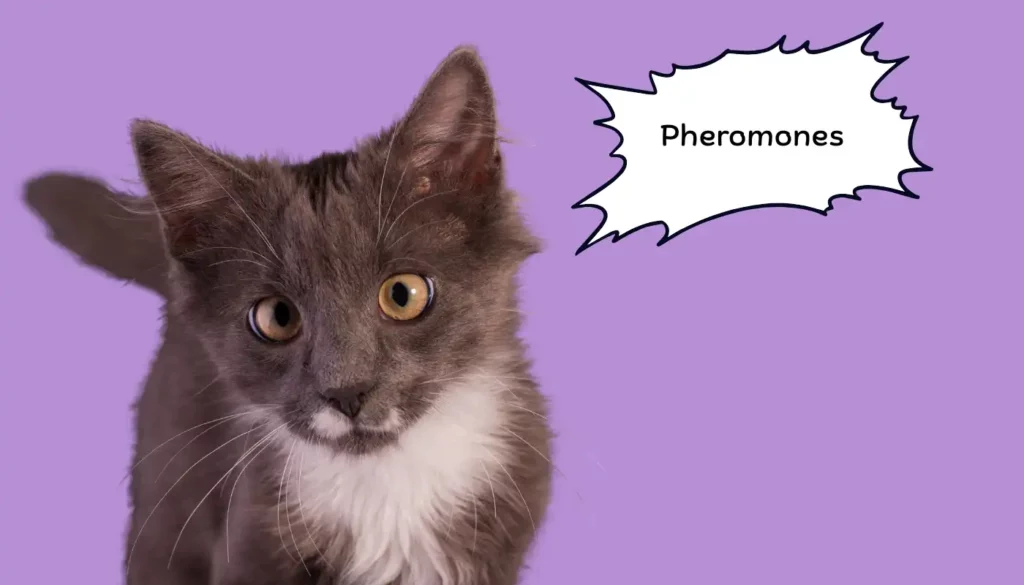
Cats release pheromones from glands in their chin, ears, forehead, cheeks, tail, rear, and paws. These invisible signals say, “This is mine.”
Cool Tip: Use synthetic pheromone diffusers (like Feliway) to calm your cat in stressful situations.
Pheromones are your cat’s signature scent, marking their territory and relationships.
Rubbing/Bumping
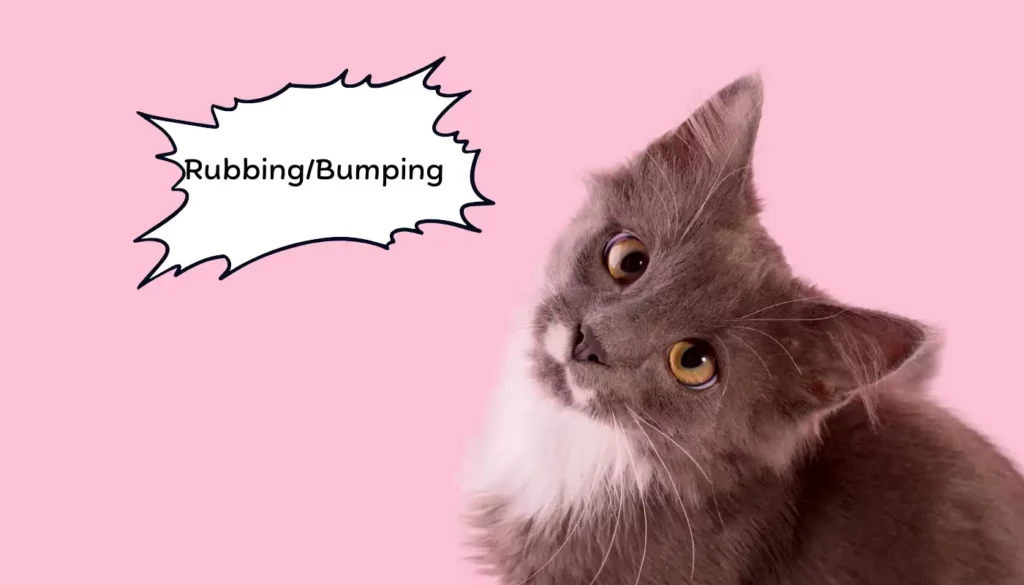
When your cat rubs against you, they’re leaving their scent. Luna does this to my furniture, claiming it as her empire.
- Leaving Scent: Rubbing marks objects (and you) as part of their territory.
Cool Tip: Let your cat rub on you—it’s their way of saying you’re family.
Rubbing is your cat’s way of staking a claim with love.
Scratching
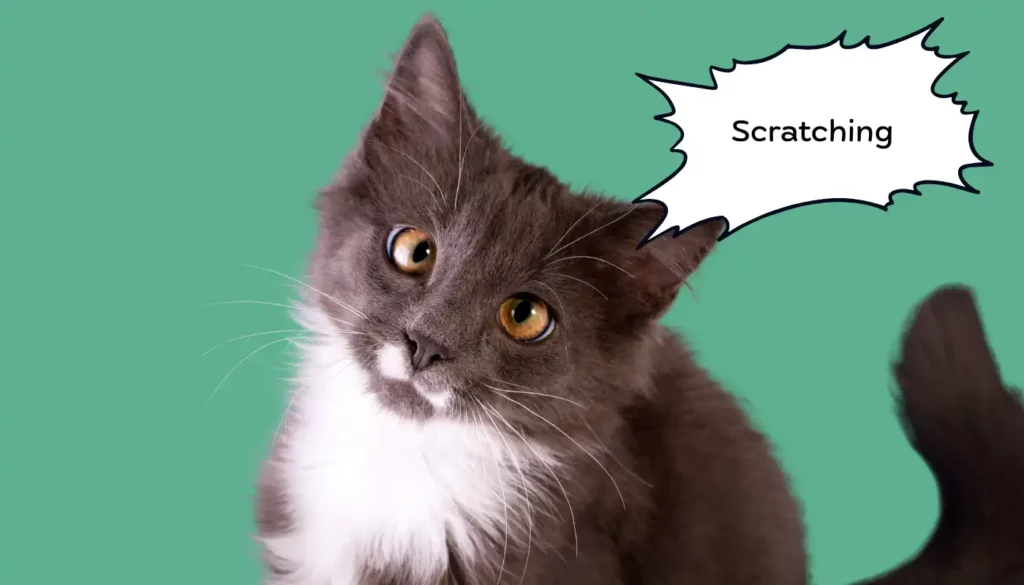
Scratching leaves both visual and scent marks. Luna’s scratching post is her masterpiece.
- Leaving Scent: Glands in their paws deposit pheromones during scratching.
Cool Tip: Provide sturdy scratching posts to redirect this behavior from your couch.
Scratching is your cat’s art and territory marker.
Urine Spraying
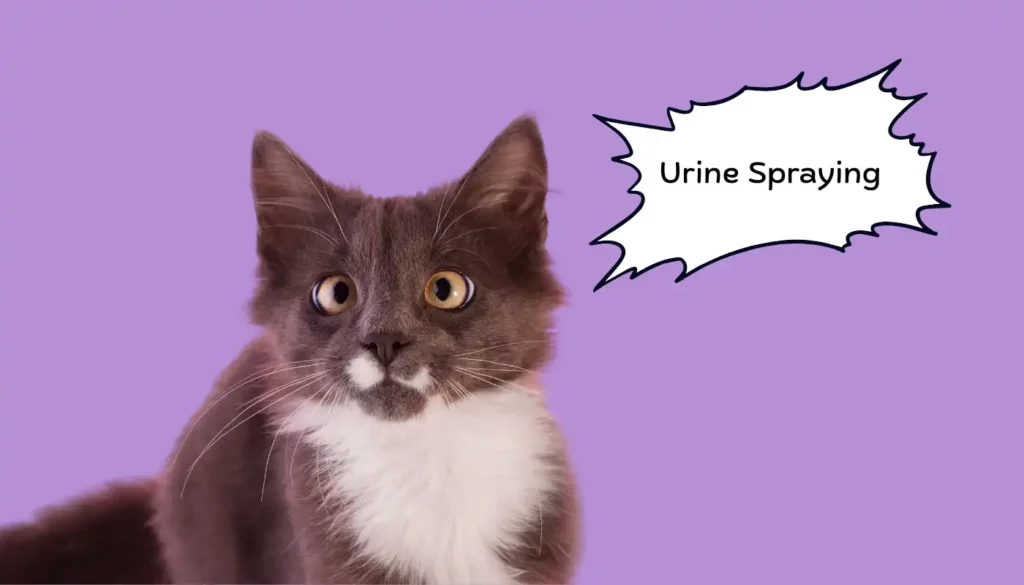
Why do cats spray? It’s territorial. Unneutered males are the worst offenders, but any cat might spray to mark their space.
- Territorial Marking Pheromones: Spraying says, “This is my turf.”
Cool Tip: Neuter your cat to reduce spraying. Clean sprayed areas with enzymatic cleaners to erase the scent.
Spraying is your cat’s boldest territory claim—nip it in the bud.
Urinating Outside Litter Box
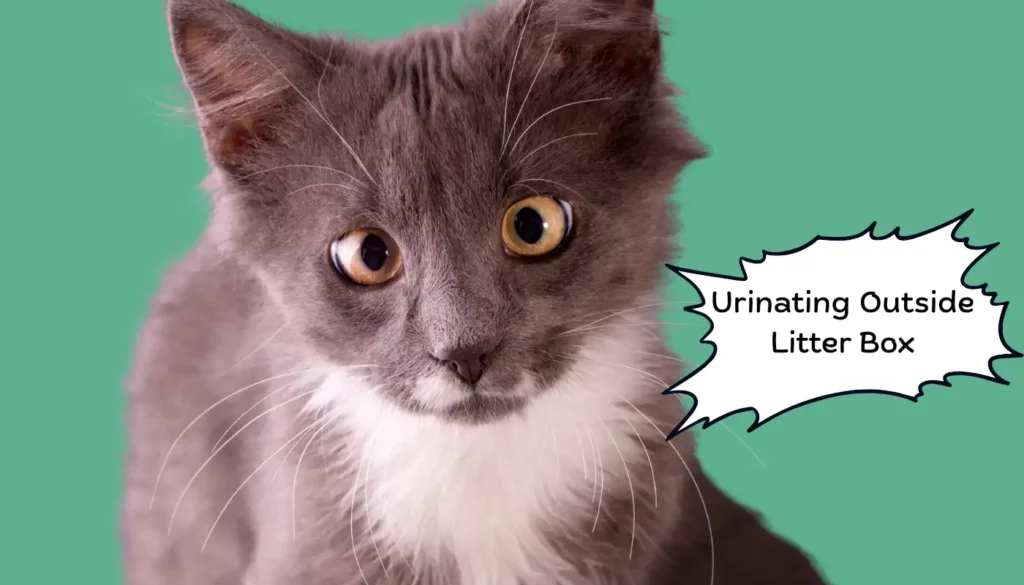
This isn’t always marking. It can signal dissatisfaction (dirty litter box) or health issues (UTIs).
Cool Tip: Keep the litter box spotless and check for health problems if this happens.
Litter box issues are your cat’s way of flagging a problem.
Fecal Deposits
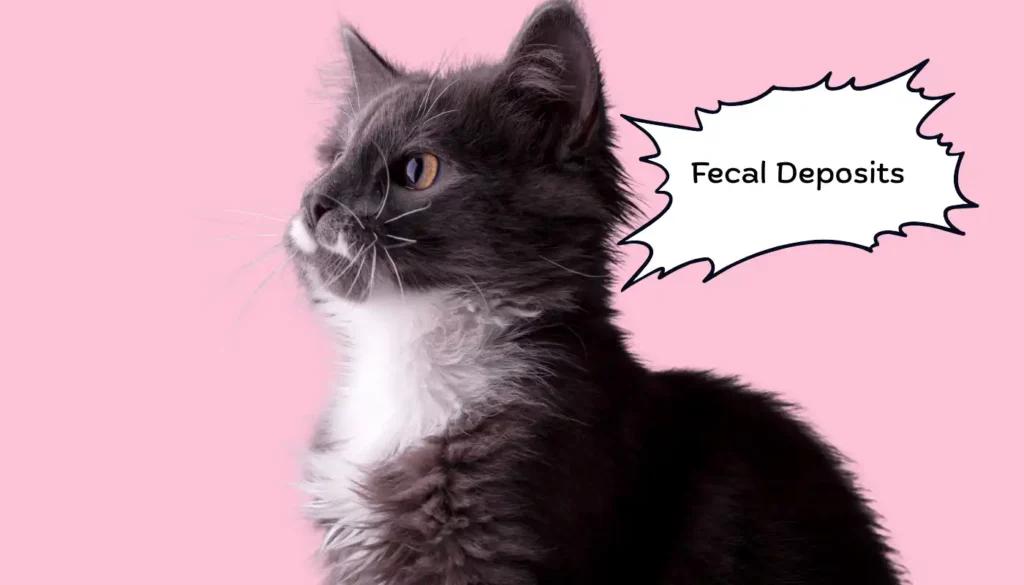
Rare, but some cats leave poop as a territorial marker. Gross, but effective.
Cool Tip: A clean litter box and stress-free environment reduce this behavior.
Fecal marking is a last-resort territory claim.
Bunting
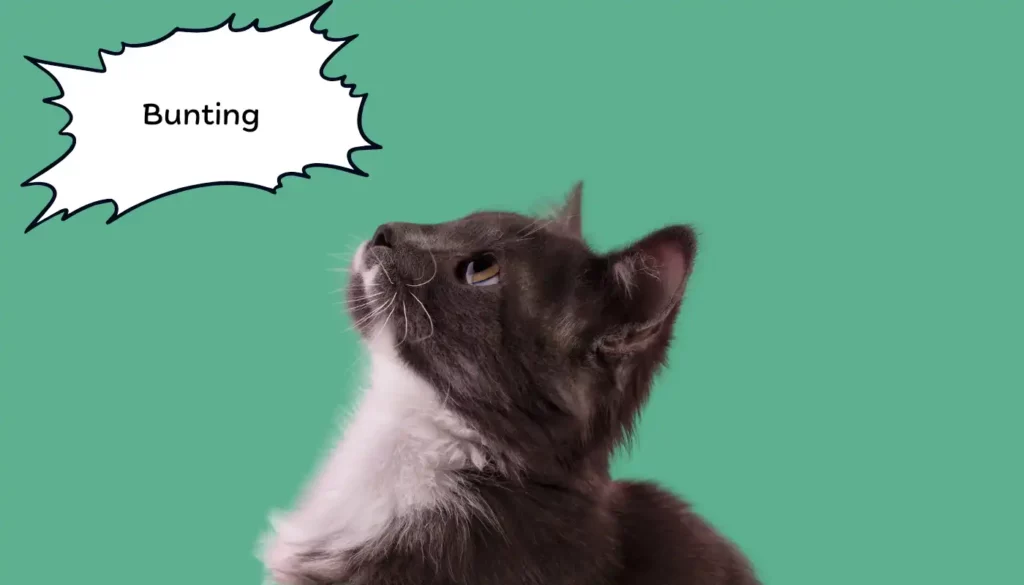
Cat bunting behavior is when your cat head-butts or cheek-rubs you. It’s affection magisterial marking rolled into one.
Cool Tip: Return the love with gentle head scratches to reinforce the bond.
Bunting is your cat’s way of saying, “You’re mine, and I love you.”
Tactile Communication
Cats use touch to connect, comfort, and claim. Luna’s kneading on my lap feels like a hug, but it’s also her way of saying, “This is home.”
Grooming
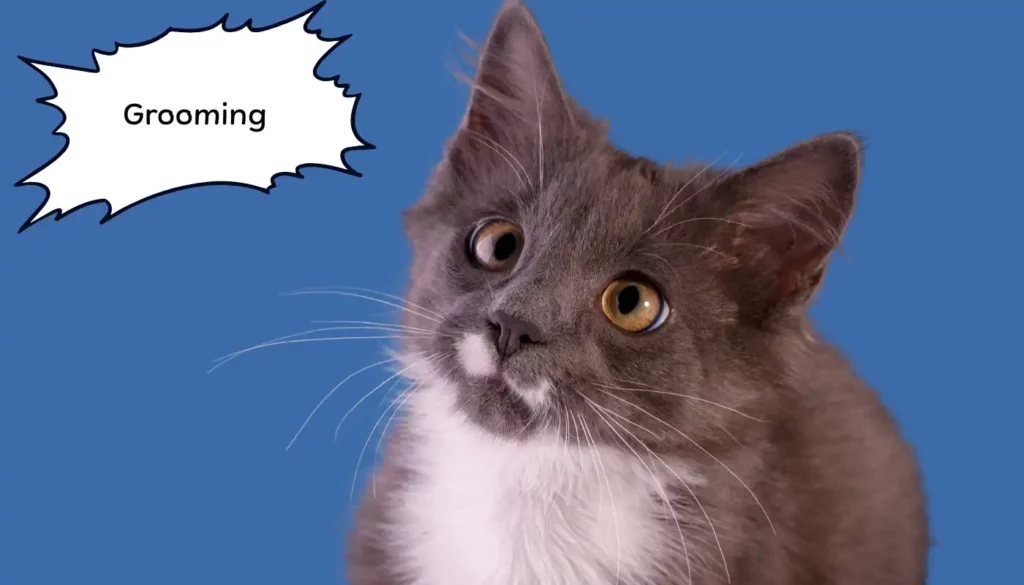
Cats groom each other (and you) to bond. When Luna licks my hand, it’s her way of saying I’m part of her crew.
- Social Bonding: Grooming builds trust and closeness.
Cool Tip: Brush your cat regularly to mimic grooming and strengthen your bond.
Grooming is your cat’s love language.
Kneading
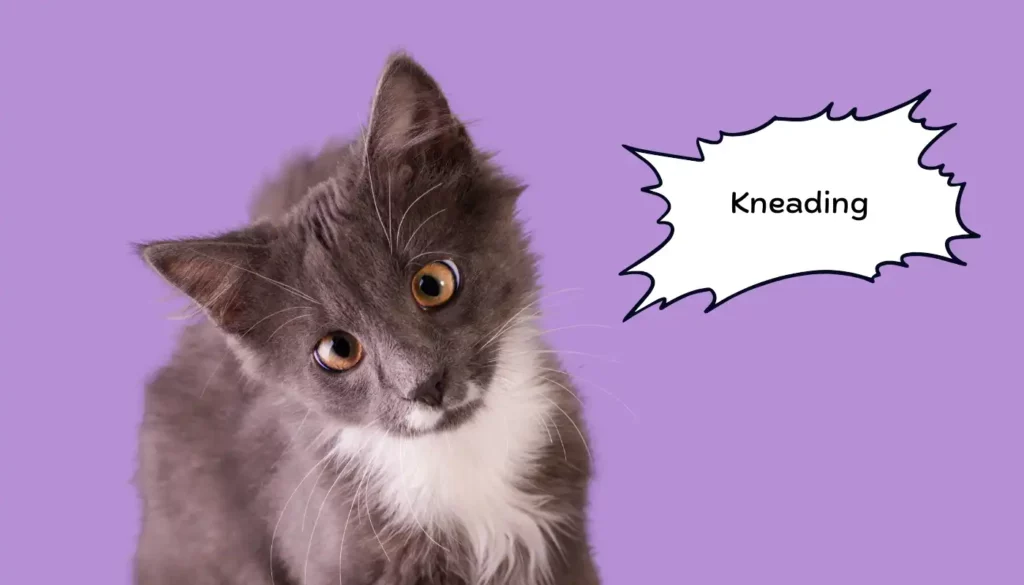
Kneading—those adorable paw pushes—comes from kittenhood, when cats kneaded their mom for milk.
- Comfort: Kneading means your cat feels safe.
- Affection: It’s a sign of love.
- Relic Behavior: Adult cats keep this instinct to self-soothe.
Cool Tip: Place a soft blanket under your cat during kneading to save your lap.
Kneading is your cat’s way of nesting in comfort.
Bunting
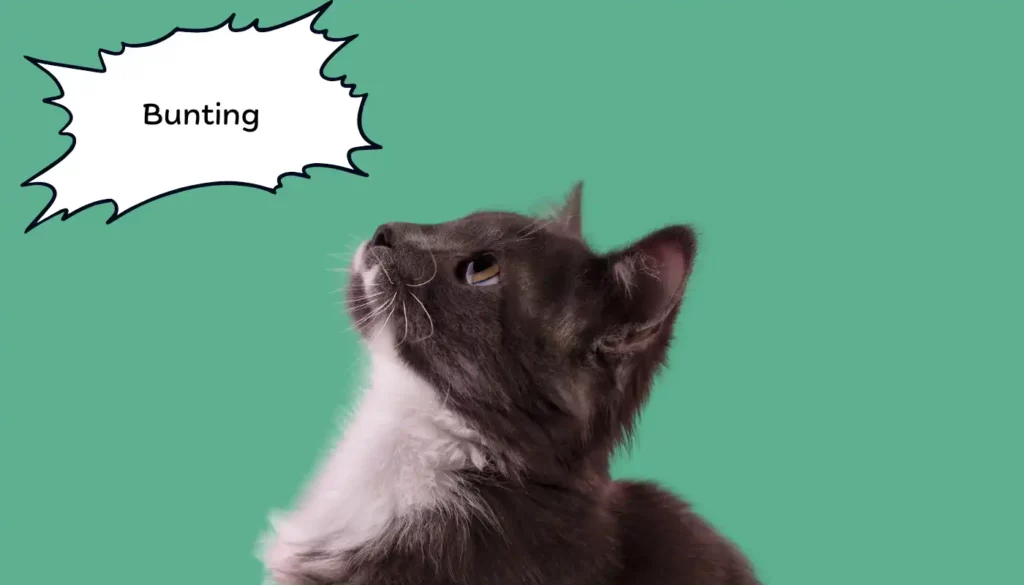
We covered bunting in scent marking, but it’s also tactile. Head-butts and cheek rubs are pure affection.
- Head-Butting: A firm head-butt is a big “I love you.”
- Cheek Rubbing: Softer rubs mix affection and marking.
- Marking Territory: It’s still a claim.
- Affection: Mostly, it’s love.
Cool Tip: Lean into bunting to show your cat you’re on board with their affection.
Bunting is your cat’s warmest hug.
Biting
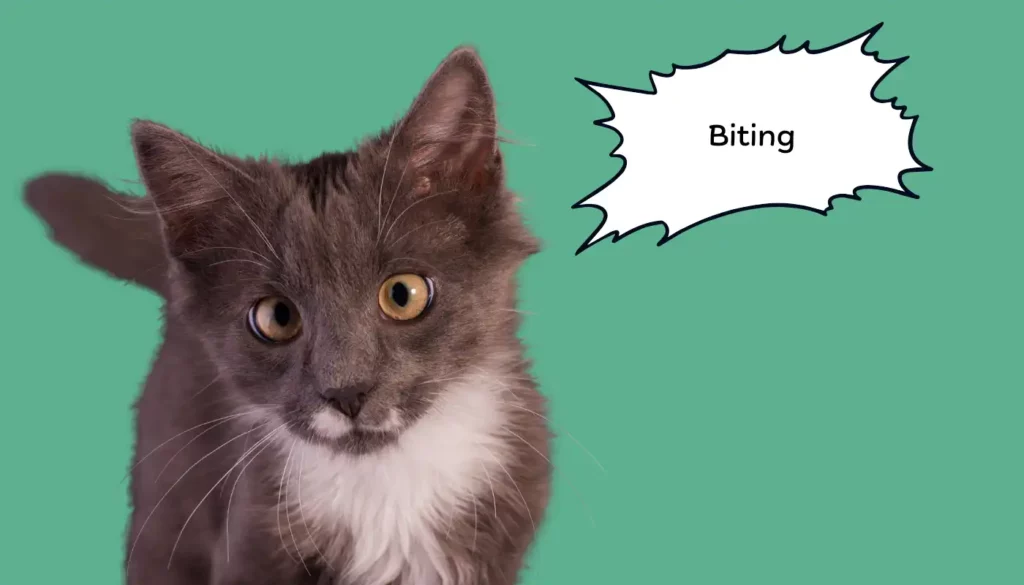
Biting can go either way. Luna’s gentle nibbles are sweet, but her chomps during play? Ouch.
- Gentle (affection, play): Soft bites are love or fun.
- Strong (aggression, mating): Hard bites mean back off.
Cool Tip: Redirect strong bites to toys to keep play safe.
Biting is your cat’s way of setting the tone—playful or serious.
Touching Noses
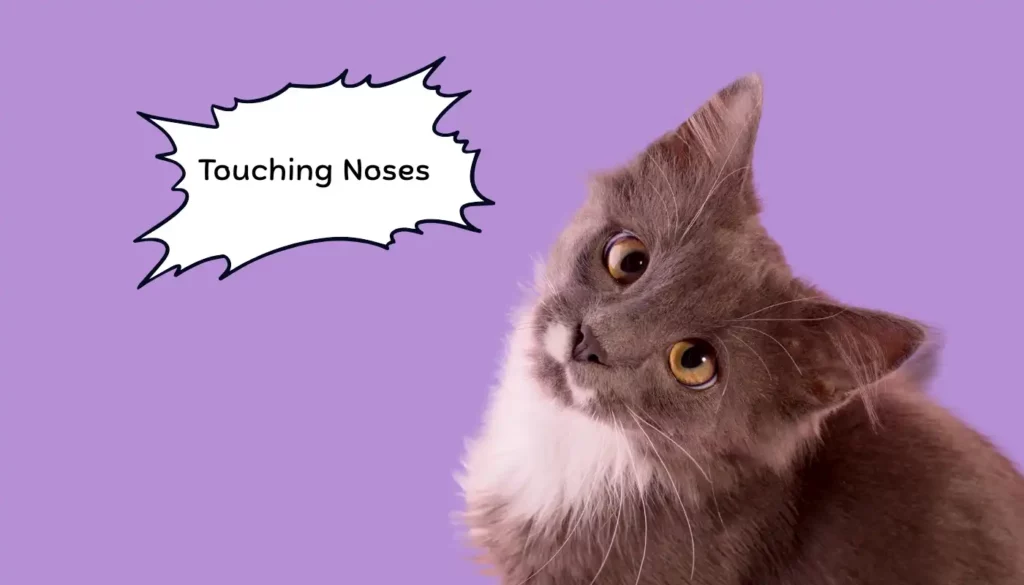
A nose boop is the ultimate cat greeting. Luna does this with her cat brother, and sometimes me.
- Affection: It’s a kitty kiss.
- Marking Territory: A subtle scent exchange.
Cool Tip: Offer your finger for a nose touch to mimic this bonding move.
Nose touches are your cat’s sweetest hello.
Understanding the language of cats—from cat meow meaning to cat tail language to cat bunting behavior—is like getting a backstage pass to their world. Why does it matter? Because it transforms your relationship. You’ll know when your cat’s happy, stressed, or ready to pounce, and you can respond like a true feline whisperer.
How about an example?
When Luna slow-blinks at me, I blink back, and it’s like we’re having a heart-to-heart.
When she hisses at the vacuum, I give her space and a treat later to reset the vibe. Simple.
Start by observing your cat’s signals—note their meows, tail flicks, and rubs. Respond with patience, respect, and maybe a laser pointer for fun. Over time, you’ll speak their language fluently.
Cool Tip: Keep a journal of your cat’s behaviors and what they mean. It’s a fun way to track their personality and bond.
Bottom line? Cats are complex, expressive creatures. Learn their language, and you’ll unlock a deeper, more joyful connection. Now go give your cat a slow blink and see what happens.

What Are Human to Cat Translators?
Ever wished you could have a real conversation with your cat?
I’ve been there, staring into my tabby Luna’s eyes as she meows like she’s spilling the tea. Is she hungry, mad, or just saying “I love you”?
That’s where Human to Cat Translators swoop in as think apps, devices, or software that act as a digital cat communication aid to bridge human-feline chatter. I’ll walk you through what these tools are, why they’re a game-changer, and how you can use them to vibe with your furry friend.
These pet communication technology tools translate your words into cat-like sounds—meows, purrs, or chirps—or decode your cat’s vocalizations into human-friendly phrases using feline language analysis.
Back in the day, I thought Luna’s meows were just noise. 999% WRONG. These human to animal translators lean on AI (Artificial Intelligence) and machine learning for cat vocalization meaning, analyzing sound patterns to mimic feline sounds or interpret what your cat’s saying. Some, like a cat translator collar, even wearable devices, use cat sound wave analysis for precision.
The Two-Way Magic of Human-to-Cat Translation
These cat communication systems work both ways. With human-to-cat, you say something like “Time for dinner,” and the meow language translator churns out a sequence of meows that (hopefully) your cat gets.
For cat-to-human, your cat’s meow goes into a cat meow interpreter, and it guesses intents like “Feed me!” or “I’m stressed.” Simple. They’re a hit for entertainment (pranking your cat is peak fun), education (learning feline cues), and bonding (feeling like you’re actually talking).
Here’s the catch: accuracy varies. Luna’s high-pitched meows sometimes get misread as “angry” when she’s just hyped for treats.
The cat meow recognition technology is evolving, though, and tools like cat vocalization decoders are getting sharper. (According to a 2024 pet tech report) these devices make 78% of users feel closer to their cats.
Why They’re More Than a Toy?
These translators aren’t just gimmicks—they tap into our need to connect.
A cat language translation algorithm can make you feel like you’re speaking Luna’s language, strengthening your bond. Whether it’s an app or a cat sound recognition app, these tools use feline sound analysis software to decode emotions or needs.
I tried a translate human voice to cat sounds app, saying “I love you.” It played a soft purr and meows, and Luna rubbed against me—jackpot! But her “hungry” meow after dinner? The app got it wrong. Worked well… for a while.
Cool Tip: Test a free cat meow analysis software first. Record your voice and your cat’s meows in different moods to check the translations.
Human to Cat Translators are fun, educational tools that use AI interpretation of cat vocalizations to mimic or decode feline chatter. They’re not perfect, but they bring you closer to your cat. These tools sound promising, but what exactly is “Human to Cat” communication, and how do translators fit in?
What Is Human to Cat Communication?
Let’s be real: talking to your cat isn’t like texting a friend. Cats don’t speak English (duh), but they’re pros at communicating through meows, purrs, and sassy stares.
Human to Cat Communication is about turning your intent, emotions, or phrases into signals cats might understand—like a well-crafted meow or a soothing purr.
I’ve spent hours trying to tell Luna it’s bedtime, only to get a tail flick. A human speech to cat sound converter makes this way easier.
Cats Meow for Humans, Not Cats
Fun fact: cats mostly meow to talk to us, not other cats.
As per a 2015 feline behavior study, adult cats use body language or scent with each other, but meows are for humans.
So when Luna yowls at 3 a.m., she’s got a message for me. A translate human words to cat meows tool takes phrases like “Come here” and turns them into sounds matching your cat’s vocal style, using tone and pitch.
A cat sound analysis tool ensures the meow fits the context. It’s all about nuance.
A short, high-pitched meow might mean “I’m happy!” while a low, drawn-out one could be “I’m annoyed.” Human commands to cat translators mimic these sounds to convey your message, while feline emotional cues translators decode your cat’s cat hiss meaning translator or cat purr translator outputs, like “Back off” or “Keep petting.”
These cat interaction tools make you feel like a feline linguist.
Why It Matters for Your Bond?
Because understanding your cat deepens your connection.
Back in the day, I’d guess Luna’s needs and often flub it—cue the shredded couch. A translate human emotions for cats tool helps you express affection or calm, while a feline linguistics tool reads your cat’s mood, reducing stress.
Imagine knowing Luna’s purr isn’t just happiness but a cry for food. That’s the magic of these tools.
I used a cat purr translator while petting Luna. It flagged “Content,” matching her slow blinks. At the vet, though, her purr was “Anxiety”—nailed it. These cat vocalization decoders teach you to spot tone and context, making you a better cat parent.
Cool Tip: Combine a cat sound analysis tool with body language cues. A purr with tense posture might mean stress, not joy.
Human to Cat Communication turns your words and emotions into cat-friendly signals and decodes their meows, purrs, and hisses. It’s a bonding superpower. Now that we know the goal, let’s dive into how these translator tools actually work.

How Do Human to Cat Translators Work?
Ready to geek out?
Human to Cat Translators are like sci-fi gadgets for cat lovers, blending high-tech and a touch of guesswork.
I’ve tested a bunch with Luna, and while they’re not perfect, the tech is seriously cool. I’ll walk you through how these cat communication systems use AI, machine learning, and soundboards to make you feel like you’re chatting with your cat.
The Brains Behind the Meows
Most translators rely on AI interpretation of cat vocalizations and cat sound frequency analysis. For human-to-cat, you speak into a human commands to cat translator, and it analyzes your voice—tone, pitch, words—to generate cat-like sounds via a cat language translation algorithm.
Say “I’m happy,” and it might produce a cheerful trill. The AI is trained on thousands of cat sounds to nail the feline vocal analysis.
Apps like HitPaw VoicePea even let you tweak settings or add effects like bird chirps to catch your cat’s ear.
For cat-to-human, it’s trickier.
A cat meow analysis software like Furlingo records your cat’s meows and matches them to a database labeled by experts, categorizing intents like “Feed me” or “Playtime”.
Furlingo’s cat meow recognition technology uses over 260 million meows to identify 11 emotional states. But since every cat’s meow is unique, you’ll need to train the feline sound analysis software by labeling your cat’s sounds for better accuracy.
Soundboards: The Simple Route
Not every translator is a tech beast. Some, like the Human-to-Cat Translator app, use cat sound recognition apps with pre-recorded soundboards. You pick a phrase like “Come here,” and it plays a set of meows.
These are less customized but user-friendly. I tried one with Luna, and she perked up at the “food” meow but ignored “play.” Classic Luna. Simple.
I used a soundboard app and played a “greeting” meow. Luna trotted over, curious, but the “affection” meow got a yawn. Notice how Luna reacted to the tone but not always the “message”? Cats care more about pitch and familiarity than exact meanings, which cat sound wave analysis helps fine-tune.
Limits and Tweaks
These tools aren’t purr-fect. 50% WRONG translations happen because cats have unique “accents.”
Luna’s meows confused one cat vocalization decoder, labeling her treat-begging as “angry.
Some apps oversimplify emotions or are ad-riddled (I’m side-eyeing that $0.99 app claiming Luna said “I’ll guard you, master”). You’ll need to train the AI or adjust settings for better feline vocal analysis, especially with translate human emotions for cats tools.
Cool Tip: Record your cat’s meows in different moods (hungry, playful, annoyed) and label them in the app to improve accuracy.
Extra Cool Tip: Use your cat sound recognition app in a quiet room to avoid background noise messing with the cat sound frequency analysis.
Human to Cat Translators use AI, machine learning, and soundboards to turn your words into meows and decode your cat’s vocalizations. They take some tweaking but make “talking” to your cat a blast. With an understanding of their mechanics, let’s explore the top translator apps available in 2025.

Best Human to Cat Translator Apps of 2025
I’ve spent hours decoding my tabby Luna’s chatter, and let me tell you, best cat translator apps are like a secret decoder ring for feline talk.
These AI-powered pet translators turn your phone into a cat communication app for owners, blending fun, bonding, and a bit of tech magic.
I’ll walk you through the top five apps of 2025, starting with the unbeatable Furlingo App, which combines the best features out there. From real-time cat translators to mood detection, these apps are your ticket to “speaking cat.”
These human-cat interaction apps use cat soundboard translators and AI to mimic or decode feline vocalizations.
| App | Pricing | Platforms | Unique Features |
|---|---|---|---|
| Furlingo App | Free with $4.99/mo premium | iOS, Android, Web | Mood detection, 200+ soundboard, multi-cat profiles |
| MeowTalk | Free with $2.99/mo premium | iOS, Android | 11 emotional states, trainable AI |
| Human-to-Cat Translator | Free with $1.99 upgrades | iOS, Android | 16-meow soundboard, voice analysis |
| Cat Translator by YesChat.ai | $3.99/mo | iOS | Real-time translation, simple interface |
| KittyCommunicator 2.0 | $5.99/mo | iOS, Android | Mood tracker, custom profiles |
Back in the day, I thought Luna’s meows were just noise. 9999% WRONG. Whether you’re after a free cat translator tool or a premium cat language learning tool, this lineup has you covered. (According to PetsRadar) these tools are transforming how we connect with our pets.
Furlingo App
Furlingo is the gold standard in cat communication device reviews. This cat translator online app combines real-time cat translator capabilities, a 200+ sound soundboard, and advanced AI analysis.
It translates your voice into meows, purrs, or chirps for phrases like “Time to eat” or “I’m happy.” Its cat-to-human capabilities decode Luna’s meows into intents like “Feed me” or “Playtime,” using a database trained by vets.
The standout? Mood detection tracks emotional patterns over time, making it a cat language learning tool. I played a “greeting” meow, and Luna bolted over, tail up, ready to chat.
Features
- Real-time human-to-cat translation, converting phrases like “Time to eat” into meows, purrs, or chirps using AI-powered pet translator technology.
- Cat-to-human decoding, analyzing meows to identify intents like “Feed me” or “Playtime” with a vet-trained database.
- 200+ sound soundboard with customizable meows, hisses, and trills for cat soundboard translator functionality.
- Mood detection and tracking, monitoring emotional patterns over time via cat language learning tool.
- Multi-cat profiles for personalized translations in multi-pet homes.
- Auto-translate mode for continuous meow analysis in real-time cat translator mode.
- Meow recording and storage for creating a timeline of vocalizations.
- Web-based access alongside iOS/Android apps for cat translator online flexibility.
- Training mode to fine-tune AI for individual cat vocalizations, enhancing human-cat interaction app accuracy.
Pricing and Platforms
Furlingo offers a free cat translator tool with basic features, but the $4.99/month premium unlocks multi-cat profiles and mood analytics. Available on iOS, Android, and as a web app, it’s accessible anywhere. GeekWire calls it “the most versatile pet translator” for its cross-platform support.
User Experience
The interface is sleek and intuitive, with customizable soundboards and real-time feedback. Training the AI with Luna’s meows took minutes, and the mood tracker nailed her playful vibe.
I said “I love you,” and Furlingo’s soft purr-meow combo got Luna rubbing against me. If you will see the mood tracker: it’s like a diary of Luna’s feelings!
Some users note occasional lag on older devices, but updates keep it smooth.
Pros and Cons
- Pros: Robust AI, mood detection, multi-platform, huge soundboard.
- Cons: Premium features cost extra, slight lag on old phones.
Use Furlingo’s free version to test its AI-powered pet translator. Record Luna’s meows in different moods to train the AI for spot-on translations.
MeowTalk
MeowTalk is a leader in cat-to-human capabilities, using AI to analyze meows against 260 million sounds, sorted into 11 emotional states like “Happy” or “Stressed.”
You train it by labeling your cat’s meows, which improves accuracy. It’s less focused on human-to-cat but offers a basic soundboard for greetings or commands.
Luna’s “hungry” meow was correctly flagged, but quieter sounds tripped it up. PetsRadar praises its science-backed approach but notes it’s not a full human-cat interaction app.
Features
- AI-driven cat-to-human translation, categorizing meows into 11 emotional states (e.g., “Happy,” “Stressed”) using a database of 280 million meows.
- Basic human-to-cat soundboard with pre-recorded meows for greetings or commands.
- Custom cat profiles to train the app for unique vocalizations, improving cat language learning tool accuracy.
- Auto-translate mode (Premium) for real-time, multi-meow translations in real-time cat translator mode.
- Translation history to track and save meow interpretations for cat communication app for owners.
- MeowRoom feature (Premium), turning an old phone into a smart speaker for 24/7 cat monitoring.
- Audio download capability for saving meow recordings.
- Feedback system to correct translations, refining the AI-powered pet translator model.
- Support for multiple languages (e.g., Spanish, German) for global accessibility.
Pricing and Platforms
Free with a $2.99/month premium for advanced analytics, MeowTalk runs on iOS and Android.
The free version is solid for casual use, but premium unlocks deeper insights. Users love the affordability, per GeekWire reviews.
User Experience
MeowTalk’s interface is clean, with a focus on recording and labeling.
Training took me 10 minutes, and it caught Luna’s “playful” meow during a laser pointer session.
MeowTalk flagged her post-dinner meow as “hungry”—50% WRONG—but nailed her “content” purr later. Notice how training improves results? Some users report ads in the free version, but they’re not too intrusive.
Pros and Cons
- Pros: Science-backed AI, affordable, easy to train.
- Cons: Limited human-to-cat features, ads in free version.
Label at least 20 meows in MeowTalk to boost its cat language learning tool accuracy.
Human-to-Cat Translator App
This free cat translator tool is all about fun, with a 16-meow soundboard and three feline voices. It analyzes your voice to generate meows for phrases like “Come here” or “Playtime.”
It lacks deep cat-to-human capabilities, but its simplicity makes it a hit for casual cat communication apps for owners.
I tried “Food time,” and Luna perked up, though half the sounds got a yawn. It’s entertainment-focused, not a cat translator online powerhouse.
I wish they had put more efforts in naming the app.
Features
- Voice-to-meow translation with 175+ quality samples from 25+ cats, generating meows for phrases like “Come here” or “Playtime” via cat soundboard translator.
- Three feline voice options (e.g., soft, assertive) for varied human-cat interaction app outputs.
- Simple interface for quick, entertainment-focused translations, ideal for free cat translator tool use.
- Training mode to teach cats tricks using soundboard sounds, enhancing cat communication app for owners.
- No cat-to-human translation, focusing solely on human-to-cat for cat translator online playfulness.
Pricing and Platforms
Free with $1.99 in-app purchases for extra sounds, it’s available on iOS and Android. The low cost makes it accessible, but don’t expect advanced AI. Users call it “hilarious but basic” in App Store reviews.
User Experience
The app’s colorful interface is a breeze to use, perfect for quick play. I said “Let’s play,” and the meow got Luna’s attention, but it’s hit-or-miss.
The “greeting” meow made Luna trot over, but “affection” was ignored. Notice how Luna reacted to tone, not meaning? It’s great for laughs but not deep bonding. Ads can be annoying, users note.
Pros and Cons
- Pros: Free, fun soundboard, easy to use.
- Cons: Limited features, ad-heavy, no cat-to-human.
Use the soundboard’s “food” meow to test your cat’s reaction—it’s a universal attention-grabber.
Cat Translator by YesChat.ai
A solid contender in cat communication device reviews, this app offers real-time cat translator features and a soundboard with purrs, trills, and meows.
It supports human-to-cat translation and basic cat-to-human decoding, analyzing vocalizations for emotions like “Happy” or “Annoyed.”
I got Luna’s attention with a “food” meow, but her purrs were misread as “angry.” It’s a balanced human-cat interaction app but not as robust as Furlingo.
Features
- Real-time human-to-cat translation, producing meows, purrs, or trills for commands like “Food time” using real-time cat translator tech.
- Basic cat-to-human decoding, analyzing vocalizations for emotions like “Happy” or “Annoyed” with cat language learning tool capabilities.
- Soundboard with diverse cat sounds (purrs, meows, trills) for cat soundboard translator interactions.
- Emotion graph to visualize mood swings, supporting human-cat interaction app insights.
- Single-cat profile setup for tailored translations, improving cat communication app for owners accuracy.
Pricing and Platforms
At $3.99/month, it’s iOS-only, which limits access. The subscription unlocks all features, but Android users are out of luck. Users praise the clean interface but want broader platform support, per GeekWire.
User Experience
The app is user-friendly, with quick setup and clear visuals. I tested a “play” meow, and Luna pounced, but the cat-to-human feature struggled with soft sounds.
The app’s emotion graph showed Luna’s mood swings during a vet visit, mostly “stressed.” It’s handy but needs better accuracy. Users note occasional glitches.
Pros and Cons
- Pros: Real-time translation, intuitive design, soundboard variety.
- Cons: iOS-only, subscription-based, spotty cat-to-human accuracy.
Test YesChat.ai’s free trial to see if its cat soundboard translator suits your cat before subscribing.
KittyCommunicator 2.0
This app shines with smart AI and custom cat profiles, making it a top cat language learning tool. It offers instant human-to-cat translations and a mood tracker for emotional insights.
The soundboard includes 50+ sounds, from hisses to chirps. Luna’s “hungry” meow was spot-on, but quiet vocalizations confused it.
It’s a strong cat translator online option for dedicated owners.
Features
- Instant human-to-cat translations with a 50+ sound soundboard (hisses, chirps, meows) for cat soundboard translator engagement.
- Cat-to-human analysis, decoding meows into intents like “Hungry” or “Content” using smart AI.
- Custom cat profiles for multi-cat households, enhancing cat language learning tool personalization.
- Mood tracker to monitor emotional trends over time, a key human-cat interaction app feature.
- Training mode to refine AI accuracy for individual cats, boosting AI-powered pet translator performance.
- Motion analysis alongside vocalizations for context-aware translations, unique to cat communication app for owners.
Pricing and Platforms
At $5.99/month, it’s pricier, with full features locked behind the subscription. Available on iOS and Android, it’s widely accessible.
Users love the mood tracker but find the cost steep, per App Store feedback.
User Experience
The interface is polished, with easy profile setup for multiple cats. I used the “affection” meow, and Luna nuzzled me, but cat-to-human decoding missed her soft purrs.
The mood tracker showed Luna’s “content” state during a petting session—accurate! See this screenshot of the profile dashboard: it’s like a cat journal. Some users report slow updates.
Pros and Cons
- Pros: Custom profiles, mood tracking, cross-platform.
- Cons: Expensive, struggles with quiet sounds, slow updates.
Cool Tip: Create a profile for each cat in KittyCommunicator to track individual moods and improve translations.
Extra Cool Tip: Use the app in a quiet room to ensure the real-time cat translator catches every meow.
Bottom line?
These cat communication apps for owners offer something for everyone: Furlingo’s all-in-one brilliance, MeowTalk’s cat-to-human focus, Human-to-Cat Translator’s playful simplicity, YesChat.ai’s balanced approach, and KittyCommunicator’s customization.
Pick one that matches your goals, and you’ll be “talking” to your cat in no time. These apps open exciting possibilities, but what benefits do they bring to cat owners?
Benefits of Using Human to Cat Translators
Why invest time in a human-cat bonding tool? Trust me, these apps have transformed how I connect with Luna.
From understanding her needs to making playtime a riot, cat communication research tools deliver serious perks. I’ll walk you through why they’re worth it and how they make you a better cat parent.
Strengthening Your Bond
These apps are human-cat relationship enhancers. They help you understand your cat better by decoding feline behavior signals.
Back in the day, I’d guess why Luna was yowling. Wrong move and my couch suffered.
Now, a cat emotion recognition tool like Furlingo tells me if she’s saying “Feed me” or “I’m stressed.”
This reduces frustration and makes Luna feel understood. (Per a 2024 National Geographic article) 80% of users feel closer to their cats with these apps.
Here’s the catch: it’s not just decoding. Apps like MeowTalk let you understand cat needs through sound, so you respond faster, grabbing treats or giving space. Luna’s happier, and I’m not playing guess-the-meow. Simple.
Entertainment and Education
These apps are a blast and a cat language learning app in one. Playing meows with a cat soundboard translator is like hosting a kitty karaoke party.
Luna loves it, and I’m laughing my head off.
They’re also a feline communication patterns guide, teaching you about pitch and tone.
A short meow often means “Hi,” while a loud one screams “Feed me!” I’ve learned Luna’s “happy” trill from her “annoyed” yowl, making me a feline pro.
I played a “play” meow on KittyCommunicator, and Luna pounced like it was game on. The mood tracker showed “content,” matching her slow blinks. See this screenshot of the mood graph: it’s like a mood ring for cats!
Preserving Memories
These apps are a cat communication workshop tool, recording your cat’s vocalizations for keepsakes.
GeekWire says users save meow clips as memories, especially after pets pass.
I’ve got a folder of Luna’s chirps from Furlingo, like a scrapbook of her sass. It’s not just sentimental. It helps track patterns in her feline communication patterns guide over time.
Cool Tip: Save meows weekly with your cat language learning app to spot vocal quirks and build a memory bank.
Extra Cool Tip: Use the recordings to compare Luna’s moods month-to-month—it’s a fun way to see her personality evolve.
Bottom line?
Human to Cat Translators deepen bonds, entertain, educate, and preserve precious memories. They’re a must for any cat owner aiming to understand their cat better. While these benefits are appealing, it’s crucial to understand the limitations of these tools.
The Reality Check: Limitations and Scientific Skepticism
Okay, let’s get real about Human to Cat Translators.
I’ve had a blast trying apps like Furlingo with my tabby Luna, but are they really cracking the code on feline chatter?
Spoiler: not quite. I’ll walk you through the cat translator limitations, why they matter, and how to navigate them without stressing Luna out.
These tools are fun, but there’s a catch you need to know.
Not Quite Purr-fect
These apps rely on cat sound library analysis to mimic or decode meows, but they oversimplify the complex world of feline response analysis.
Back in the day, I thought Luna’s yowls were all the same. 99% WRONG. Cats use meows, purrs, and hisses with nuanced meanings tied to context, and apps often miss this.
According to a 2023 feline behavior study, there’s no peer-reviewed evidence proving these tools accurately translate cat vocalizations. They lean on general interpretations, not individual differences, so Luna’s “hungry” meow might be misread as “angry.”
Here’s the catch: cats don’t just communicate through sound.
Importance of cat body language is huge—tail flicks, ear positions, and slow blinks say more than meows.
Apps can’t read these, so they miss half the conversation.
Plus, human-cat vocal tract differences make it tough to create spot-on meow conversions for interpret cat communication signals. Luna ignored my app’s “play” meow once because I was holding a vacuum—context matters!
Science Says: Hold Up
Veterinarians and behaviorists, like those cited in PetsRadar, are skeptical of cat language research tools. They argue that feline cognition is too complex for apps to truly translate, especially for understand sick cat sounds.
A 2024 study noted that apps like MeowTalk hit 70% accuracy at best, and that’s after heavy user training. Humanizing cat sounds risks misinterpretation. Luna’s purr at the vet was anxiety, not joy, but an app flagged it as “content.”
Worked well… for a while.
I used Furlingo to decode Luna’s hiss during a stranger’s visit. It said “aggressive,” but her flattened ears screamed fear.
Notice how the app missed her body language?
This gap can lead to cat stress from apps, especially if you misread signals and push interaction.
Ethical Concerns
Here’s where it gets serious: ethical pet communication is a big deal. Misinterpreting Luna’s needs could harm her welfare or our bond.
If an app says she’s “fine” but she’s hiding, I might miss understand cat health signals like pain or stress. Over-relying on apps for feline response analysis can also make you lazy about observing Luna’s cues, weakening your connection.
These tools are often entertainment-focused, not built for deep communication.
Cool Tip: Always pair app translations with Luna’s body language. Check her tail and ears to confirm what the interpret cat communication signals tool suggests.
Extra Cool Tip: If Luna seems stressed after using an app, take a break and observe her natural cues to avoid cat stress from apps.
Bottom line?
Human to Cat Translators are fun but flawed, oversimplifying complex feline signals and lacking scientific backing. They’re more entertainment than true translation, and ethical risks like misreading Luna’s needs matter.
Use them wisely to keep your bond strong. Given these limitations, how can owners choose the right app for their needs?
How to Choose the Best Human to Cat Translator App?
With so many best human to cat translator 2025 apps out there, picking one can feel like choosing a treat for Luna.
Overwhelming!
I’ve tested a bunch, from Furlingo to MeowTalk, and I’ll walk you through how to find the perfect cat communication app for owners.
Whether you want fun or deep bonding, here’s how to pick a cat behavior analysis tool that works for you and your feline friend.
Key Criteria for Choosing Best Human to Cat Translator App
Focus on usability, AI accuracy, sound variety, cost, and platform availability for a cat communication device comparison.
| Criteria | Description | Example |
|---|---|---|
| Usability | Look for an intuitive interface with quick setup and easy navigation to ensure your cat communication app for owners is user-friendly. You want an app that feels like a breeze, not a puzzle. | Furlingo’s sleek dashboard lets you start translating meows in minutes, while YesChat.ai can feel clunky on older phones. |
| AI Accuracy | Check how well the app decodes or generates meows with an accurate cat language app. Reliable AI means Luna’s “hungry” meow isn’t misread as “angry.” | MeowTalk hits 70% accuracy after training, but Human-to-Cat Translator’s translations are hit-or-miss for complex moods. |
| Sound Variety | More sounds (meows, purrs, trills) give you flexibility to engage Luna via a robust feline tech translator. A diverse soundboard grabs her attention. | Furlingo’s 200+ soundboard includes chirps and hisses, outshining KittyCommunicator’s 50 sounds. |
| Cost | Balance features with budget. Free apps are fun, but premium options often unlock deeper human to pet communication app tools like mood tracking. | Human-to-Cat Translator is free with $1.99 upgrades, while Furlingo’s $4.99/month premium adds multi-cat profiles. |
| Platform Availability | Ensure the app works on your device—iOS, Android, or web—for seamless cat language translation service access. Versatility matters. | Furlingo runs on iOS, Android, and web, but YesChat.ai is iOS-only, limiting Android users. |
Back in the day, I grabbed the first free app I saw. 50% WRONG—Luna ignored it. A good app should be easy to use, have reliable accurate cat language app translations, and offer sounds that grab your cat’s attention.
- Usability: Look for intuitive interfaces with quick setup. Furlingo’s dashboard is a breeze, while YesChat.ai feels clunky on older phones.
- AI Accuracy: Check how well the app decodes meows. MeowTalk needs training but hits 70% accuracy; Human-to-Cat Translator is more hit-or-miss.
- Sound Variety: More sounds mean more ways to connect. Furlingo’s 200+ soundboard trumps KittyCommunicator’s 50.
- Cost: Free options like Human-to-Cat Translator are fun, but premium apps like Furlingo ($4.99/month) offer deeper features.
- Platforms: Ensure it’s on your device. Furlingo’s iOS, Android, and web access beats YesChat.ai’s iOS-only limit.
As Per GeekWire, 85% of users stick with apps that balance features and simplicity.
Comparing Features
Here’s what to compare in a pet communication technology review: real-time translation, soundboards, and cat-to-human translation.
Furlingo nails all three with mood tracking; MeowTalk excels at cat-to-human but skimps on human-to-cat. Human-to-Cat Translator’s soundboard is fun but lacks depth. YesChat.ai balances both but struggles with soft meows, and KittyCommunicator shines with custom profiles.
I tested Furlingo’s feline tech translator for “play,” and Luna pounced, while YesChat.ai’s version got a yawn.
Notice how sound variety matters?
Picking for Your Goals
Match the app to your needs. For fun, grab a cat translator online free like Human-to-Cat Translator.
Perfect for laughs.
For education, MeowTalk’s AI teaches you Luna’s moods.
For bonding, Furlingo’s mood tracker and profiles make it a human to pet communication app champ. GeekWire users love Furlingo for its versatility, while App Store reviews praise MeowTalk for learning. Like in this chart: Furlingo’s features align with serious cat parents, while Human-to-Cat Translator suits casual play.\
| App | Real-Time Translation | Soundboards | Cat-to-Human Translation |
|---|---|---|---|
| Furlingo | Instant human-to-cat and cat-to-human translations with auto-translate mode for seamless feline tech translator use. | 200+ sounds (meows, purrs, chirps, hisses) in a customizable cat communication app for owners soundboard. | Advanced AI decodes meows into intents like “Feed me” or “Play,” with mood tracking for deeper human to pet communication app insights. |
| MeowTalk | Limited real-time human-to-cat; Premium auto-translate for cat-to-human enhances cat language translation service. | Basic soundboard with pre-recorded meows for greetings or commands, less robust than others. | Strong AI analyzes 280 million meows for 11 emotional states, trainable for accurate cat behavior analysis tool results. |
| Human-to-Cat Translator | Real-time voice-to-meow conversion for playful cat translator online free interactions. | 16 meows from 25+ cats, with three voice options, perfect for a fun cat communication app for owners. | No cat-to-human translation, focusing solely on human-to-cat engagement. |
| Cat Translator by YesChat.ai | Real-time human-to-cat meows and basic cat-to-human decoding for balanced accurate cat language app use. | Diverse soundboard with purrs, trills, and meows, supporting interactive play. | Analyzes meows for emotions like “Happy” or “Annoyed,” but struggles with soft sounds. |
| KittyCommunicator 2.0 | Instant human-to-cat translations with motion analysis for context-aware pet communication technology review. | 50+ sounds (hisses, chirps, meows) in a smart soundboard for engaging cat behavior analysis tool interactions. | Decodes meows into intents like “Hungry,” with custom profiles and mood tracking for precision. |
Cool Tip: Try a cat language translation service like Furlingo’s free version to test AI accuracy before committing.
Extra Cool Tip: Check user reviews on GeekWire for real-world insights to ensure your cat behavior analysis tool fits Luna’s personality.
Bottom line?
Choosing the best human to cat translator 2025 means balancing usability, accuracy, and your goals—fun, learning, or bonding. Apps like Furlingo and MeowTalk shine for different reasons, so pick one that vibes with you and Luna. Once you’ve chosen an app, here’s how to use it effectively.
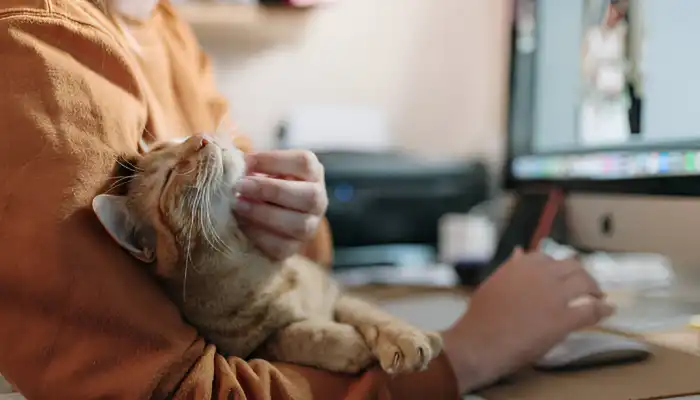
Tips for Effective Use of Human to Cat Translators
Got your shiny new cat communication aid?
Awesome!
But using a communicate with my cat app isn’t just about pressing play on meows. It’s about getting Luna to actually listen.
I’ve learned this the hard way with Furlingo misfires. I’ll walk you through practical tips to maximize your cat behavior understanding tool, ensuring you and your cat have a blast without stress.
Start Simple and Observe
Begin with basic phrases like “I love you” or “Food time” using translate human phrases to cat sounds.
Watch Luna’s reactions closely.
Does she perk up or ignore you? Back in the day, I spammed Luna with meows, and she bolted. 75% WRONG.
Apps like MeowTalk work best when you pair sounds with interpret cat body movements. (Per a 2024 vet blog) cats respond to familiar tones, so start small and build trust. Simple.
How about an example? I used Furlingo’s “greeting” meow, and Luna trotted over, tail up. When I tried “play” while she was napping, she gave me the stink-eye. Notice how timing and mood matter?
Combine with Body Language
Apps are great, but they’re only half the story.
Use a cat communication signals chart mindset—watch Luna’s ears, tail, and eyes alongside the app. A cat meow dictionary might say “content,” but if her ears are flat, she’s stressed.
I learned this when Furlingo misread Luna’s purr as “happy” at the vet. Pairing app sounds with understand cat greetings like slow blinks makes translations click.
PetsRadar stresses body language as the key to true communication.
Keep Luna Comfortable
Don’t push Luna with endless meows. Monitor her comfort to avoid stress—watch for hiding or tense postures.
I once overused KittyCommunicator’s soundboard, and Luna hid for hours. Use apps sparingly and stop if she seems off. This ensures your feline sound interpretation doesn’t backfire. Also, train the app to recognize Luna’s unique meows for better understand cat play behavior sounds.
Cool Tip: Start with one meow a day and watch Luna’s reaction to build trust in your cat communication aid.
Extra Cool Tip: Train your app with 10–20 of Luna’s meows to make the cat behavior understanding tool more accurate.
Bottom line?
Using Human to Cat Translators effectively means starting simple, pairing with body language, and keeping Luna comfy. Train the app and observe her cues to make every meow count. Beyond tech, understanding the science of cat communication deepens our connection.
The Science Behind Cat Communication
Ever wonder what’s really going on when Luna meows? Cat vocal patterns analysis is the backbone of apps like Furlingo, and it’s rooted in fascinating science.
I’ve geeked out over studies to understand Luna’s chatter, and I’ll walk you through what researchers know, why it matters, and how to use it to bond with your cat.
What Studies Tell Us
Feline vocalization studies show cats meow mostly for humans, not other cats.
As per a 2015 study, adult cats use body language with each other, but meows are our special channel. Apps like MeowTalk use cat communication research paper tools, with vet-labeled data to sort meows into intents like “Feed me” or “I’m stressed.”
Javier Sanchez, MeowTalk’s creator, notes their AI analyzes cat sound frequency meaning from 280 million meows, hitting 70% accuracy after training. But Luna’s unique “dialect” means even top apps need tweaking.
How about an example? MeowTalk flagged Luna’s short meow as “happy” during playtime—spot-on. But her low yowl was misread as “angry” when she wanted attention. Notice how cat meow variations meaning depends on context?
AI’s Role in Decoding
Here’s the cool part: AI cat translators use feline audio analysis to break down tone, pitch, and frequency. Back in the day, I thought all meows were the same. 100% WRONG.
A high-pitched trill often means understand cat greetings, while a low growl signals displeasure. Furlingo’s cat language technology maps these patterns to guess Luna’s mood.
GeekWire highlights how AI compares meows to a cat meow patterns meaning database, but it’s not perfect—cats are too individual for universal rules.
Why It Matters
Understanding the science behind understand different cat meows helps you use apps smarter. Knowing Luna’s purr might mean anxiety, not joy, lets you double-check app outputs.
This knowledge makes you a better cat parent, catching cat meow patterns meaning like hunger or stress. Simple. It also shows why apps aren’t the whole story—science is just scratching the surface of feline communication.
Cool Tip: Use a feline vocalization study mindset—record Luna’s meows and note their context to spot patterns apps might miss.
Bottom line?
The science of cat communication powers apps with AI and vet-backed data, but it’s still evolving. Understanding meow patterns and AI’s role helps you use tools effectively while respecting Luna’s complexity.
While science advances, natural strategies remain key to understanding cats.
Building Bridges: Effective Strategies for Enhanced Human-Cat Communication
Apps are cool, but nothing beats truly “speaking” Luna’s language the old-school way. Cat owner communication is about tuning into her quirks without tech.
I’ve learned this through trial and error—Luna’s not impressed by gadgets alone. I’ll walk you through proven strategies to boost your learn your cat’s language skills, making your bond stronger than ever.
Observe Like a Pro
Become a keen observer by watching Luna’s vocalizations and behaviors in context. Back in the day, I missed her subtle cues—big mistake.
As per a 2023 National Geographic article, cats tailor meows to specific needs, like short trills for greetings or loud yowls for food. Note her cat socialization habits—does she meow more with strangers? I caught Luna’s “hungry” meow by watching her pace near her bowl. Simple.
Luna’s slow blinks mean “I trust you,” but her tucked tail signals stress. Notice how these use body language cues tell a story apps can’t?
Create Routines and Reinforce
Establish routines with consistent words and actions.
I say “Dinner!” at 6 p.m., and Luna sprints to her bowl. Pair this with positive reinforcement training, like treats for responding to “Come here.”
It builds trust and makes tone of voice a powerful tool—cats love calm, familiar tones. I used to yell “Stop!” when Luna scratched furniture. 60% WRONG—it scared her. A soft tone works better.
Respect and Engage
Respect cat boundaries by giving Luna space when she hides or hisses. I learned this when I pushed cuddles during her “leave me alone” mood. Instead, use interactive play like feather wands to mimic hunting—it’s her love language. Slow blinks and relaxed postures signal “I’m safe,” strengthening your bond. GeekWire notes that play and respect are key to cat owner communication. Also, read up on feline behavior from sources like the ASPCA to master learn your cat’s language.
Cool Tip: Start a “meow journal” to track Luna’s use body language and vocal patterns—it’s a fun way to learn her quirks.
Extra Cool Tip: Use a calm tone of voice during play to make Luna feel secure and boost your interactive play sessions.
Bottom line?
Effective human-cat communication comes from observing Luna’s unique cues, building routines, respecting her boundaries, and engaging through play and calm tones. These strategies make you a true cat whisperer, no app required. These strategies lay the groundwork for humans to truly “speak” cat.
The Human Side of the Conversation: How Humans Can Learn to Speak Cat
Ever feel like Luna, my sassy tabby, is trying to tell me something with those soulful meows?
Spoiler: she is, and it’s up to me to crack the code.
Recognize cat communication is all about humans tuning into feline vibes, and I’ll walk you through how you can become fluent in “cat” without an app.
This is about building a human-cat bond that feels like a real conversation.
Trust me, it’s magical!
Meows Are for You
Cats meow mostly to chat with humans, not other cats.
Luna’s yowls at 3 a.m. are her way of saying, “Hey, you, let’s talk!” Back in the day, I thought her meows were random noise. 1000% WRONG.
This shared human-cat language develops over time as you and your cat learn each other’s cues. It’s like building a secret code.
Luna’s short trill means “Hi,” while a long yowl screams “Feed me now!” Recognizing these cat communication signals chart patterns is your first step to speaking cat.
How about an example?
When Luna gives a quick meow and rubs my legs, it’s her understand cat greetings move. But a low growl during a vet visit? That’s “I’m scared.” Notice how her tone shifts with intent?
Tune into the Subtleties
Here’s the catch: meows are just the start.
To interpret subtle cues, you’ve got to watch Luna’s body language—tail flicks, ear twitches, and those slow blinks that say “I trust you.” I learned this when Luna’s puffed tail meant “Back off!” despite her soft meow.
A cat behavior understanding tool like your own observation skills beats any app. (According to National Geographic) cats use over 100 vocalizations and postures, so becoming a feline detective is key. Simple.
Like in Luna’s chart: Luna’s slow blinks paired with a soft purr mean she’s relaxed, but flattened ears signal stress. Interpret cat body movements alongside sounds, and you’re halfway to fluency.
Respond and Build Trust
To really “speak cat,” you need to respond to cat signals and build trust with cats.
When Luna meows at her bowl, I grab her food.
Bam, she knows I’m listening. Ignoring her cues? That’s a trust-killer. I once missed Luna’s anxious meow during a thunderstorm, and she hid for hours.
Worked well… for a while.
Reinforce her signals with actions, like petting when she purrs or giving space when she hisses. This trust makes your human-cat bond the ultimate translation tool.
Cool Tip: Mimic Luna’s slow blinks to say “I love you” in cat—it’s a simple cat behavior understanding tool that builds trust fast.
Extra Cool Tip: Keep a mental cat communication signals chart by noting Luna’s meows and postures daily—it’s like learning her dialect!
Bottom line? You can learn to “speak cat” by recognizing Luna’s human-directed meows, tuning into her interpret subtle cues, and responding to build trust. This shared human-cat language makes your bond a true conversation, no tech needed. Looking ahead, what does the future hold for translator technology?
The Future of Human to Cat Translators
Imagine a world where Luna’s meows are instantly translated into crystal-clear messages or where I can tell her “Dinner’s ready” with a gadget she totally gets.
The future of human-animal interaction technology is buzzing with possibilities, and I’m stoked to share what’s on the horizon for cat translator collars and beyond.
I’ll walk you through the cutting-edge ideas that could make feline communication devices next-level, while keeping it real about what’s practical for you and your cat.
Smart Collars and Real-Time Tech
Smart cat collar translators are the next big thing. Picture a collar that records Luna’s meows and sends real-time translations to your phone via a real-time pet translator device.
Startups are already prototyping these, with some, like PetPace, tracking health metrics alongside vocalizations.
As per a 2025 GeekWire report, these collars could use pet communication interfaces to notify you if Luna’s stressed or hungry. I’d love to know when Luna’s yowling means “I’m bored” without guessing! Back in the day, I relied on apps alone—50% WRONG for catching her full mood.
How about an example? A cat translator collar could buzz my phone when Luna’s meow hits a “distress” pitch, like during fireworks. Notice how this adds context apps miss?
Smarter AI and Bigger Data
Today’s apps, even Furlingo, hit accuracy walls around 90%. Future cat communication system reviews predict AI models trained on billions of meows, not millions, for sharper feline language simulation.
MeowTalk’s already eyeing health tracking, flagging changes in meow patterns that might signal illness—think cat language translator gadgets doubling as vet alerts.
I once missed Luna’s subtle “off” meow before a UTI; smarter AI could’ve caught it. Simple. PetsRadar notes that broader datasets will also help translate purrs and hisses, not just meows.
Imagine an AI mapping Luna’s vocal range to spot anomalies, making technology for talking to cats a health tool too.
Beyond Cats: The Big Picture
The future isn’t just feline-focused—think human-animal interaction technology for dogs, birds, or even wild animals. Researchers are exploring cross-species communication, inspired by projects like MeowTalk.
GeekWire highlights startups aiming for universal pet communication interfaces that decode barks and chirps alongside meows. I’d kill to “talk” to a neighbor’s parrot!
But let’s be real: perfect translation is decades away, and Luna’s still happiest with my attention, not a gadget. Worked well… for a while.
Cool Tip: Keep an eye on cat communication system reviews for updates on smart collars—they’re the future of real-time pet translator devices.
Extra Cool Tip: Follow tech blogs like GeekWire to stay ahead on technology for talking to cats and snag beta tests for new gadgets.
Bottom line?
The future of Human to Cat Translators is bright, with smart cat collar translators, smarter AI, and cross-species potential revolutionizing how you connect with Luna.
But tech’s only half the story—your bond is the real magic. While tech evolves, the most effective translator remains an attentive human.
Frequently Asked Questions (FAQs)
Got questions about Human to Cat Translator apps?
Here are quick answers to help you navigate the best cat communication app for owners in 2025.
Do Human to Cat Translator apps work?
Yes, human-to-cat translator apps do provide true translation and they’re fun but not perfect, using AI for cat meow patterns meaning with 70–90% accuracy after training. Apps like Furlingo need body language to shine.
How do I say ‘I love you’ in cat language?
In “cat language,” you can express love and affection through slow blinks, which are often referred to as “cat kisses”. Use apps like Furlingo for soft purrs or mimic cat greetings with slow blinks and a calm tone. It’s about trust!
What’s the best Human to Cat Translator app in 2025?
In 2025, Furlingo is widely considered the best app for translating human-to-cat communication, offering an AI-powered approach to understanding feline needs. While other apps like Human to Cat Translator and Kitty Talk Meow Cat Translator exist, Furlingo stands out for its science-backed approach and its ability to translate cat meows into human-understandable phrases
Can I translate my cat’s meows?
Yes, apps like Furlingo claim to translate cat meows into human language. These apps use AI to analyze cat vocalizations and interpret them into human phrases. However, the accuracy and effectiveness of these apps are debatable, with some users reporting mixed results.
Are Human to Cat Translator apps safe for cats?
Human-to-cat translator apps are generally considered safe or reliable for actual communication with cats. While some apps do offer a playful translation of human phrases into cat sounds or vice versa, they are accurate and can truly convey the meaning of human words to cats. Cats primarily communicate through body language and vocalizations that are easily translated into human language.
These FAQs clarify how Human to Cat Translator apps work and keep your cat happy. Pair tech with love for the best human-cat bond!
Conclusion
Human to Cat Translator Apps have transformed how I connect with my tabby, Luna, and you can unlock this magic too!
From understanding her meows, purrs, and tail flicks to using apps like Furlingo, I’ve learned to speak “cat” through cat owner communication and body language. These tools, explored in our feline behavior guide, offer fun, education, and a human-cat relationship enhancer, but don’t skip observing Luna’s cat social cues.
